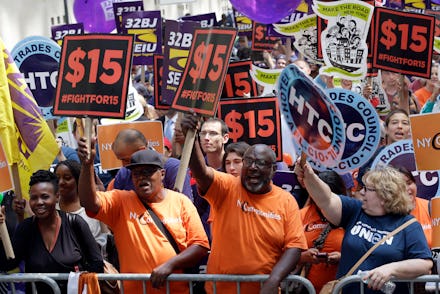The Fight for $15 Just Won Its Biggest Victory Yet. Here's What Comes Next

After more than two-and-a-half years of strikes and protests, nearly 200,000 workers assembled Wednesday under the banner of the Fight for $15 movement scored their most substantial victory yet, after the New York state wage board approved a proposal to raise the minimum hourly rate for fast-food employees from $8.75 to $15 by 2021.
New York City Comptroller Scott Stringer, a longtime backer of the movement, celebrated the win, but in an email Thursday to Mic, pointed to a coming crossroads.
"The $15 minimum wage is the most effective tool in the fight against income inequality," Stringer said. "But the fight is far from over — we must have a $15 minimum wage for all industries, including retail and health care... We are at a turning point for worker rights, and we must keep the momentum going."
Looking to seize on swelling public attention and overwhelming support for efforts to raise wage standards, home care workers Thursday afternoon and evening are enlisting in the "fight," coordinating to jump-start their cause by launching protests in at least 10 cities across the United States.
New front: "Fast-food workers started this movement for $15 and home care workers are proud to carry the banner, too," Lizabeth Bonilla, who has worked as an in-home care worker in Las Vegas for more than four decades, said after Monday's ruling came down.
In June, home care workers in Massachusetts won their fight. On Thursday, their colleagues will rally in Denver, Miami, Detroit, Las Vegas, Memphis, Atlanta, Milwaukee, Cleveland, Richmond, Virginia, and Raleigh, North Carolina.
Organizers say they are emboldened by their progress in New York and cities like Seattle, San Francisco and Los Angeles, where elected officials have green-lit transitions to an across-the-board $15 minimum wage. In rolling out his proposal Monday for a federal hike, Democratic presidential candidate Bernie Sanders, the independent senator from Vermont, used SeaTac, Washington — often cited in Fight for $15 press releases — as evidence that minimum wage controls can benefit the broader economy.
"In January of 2014, SeaTac immediately raised its minimum wage to $15 an hour," he said. "Did the unemployment rate in that community go up? No, it went down from 6.3% to 4.6%." Sanders and former Maryland Gov. Martin O'Malley are the only two candidates in the 2016 field to unreservedly back a nationwide $15 wage. Hillary Clinton has so far refused to endorse it, saying she preferred "local efforts."
Spreading the wealth: The decision in New York stands to benefit more than just fast-food workers. Activists argue that lifting standards in one sector of the low-wage job market will have a ripple effect, doing the same in parallel industries, where companies largely draw from the same pool of workers.
"I think it puts upward pressure on salaries across the board, because I certainly don't want to lose my good employees to the fast-food restaurant that's in the food court of the mall," Ted Potrikus, the president and CEO of the Retail Council of New York State, told Mic over the phone Thursday.
Potrikus, whose organization works on behalf of a range of retailers from small storefronts to national chains like Walmart, says public opinion has moved and many businesses now see it as an existential necessity to "be mindful" of the movement, especially in restaurants and retail shops where customers come face to face with the employees out picketing.
"Do we really want to poke our finger in the eye 80-plus percent of the public that says minimum-wage increases are a good thing?" Potrikus asks, a rhetorical question he's likely presented to foot-dragging business leaders. "'Oh no, we're opposed to that, but still come into our stores and shop!' I don't think that equation really works for us."
Pace of change: Though New York Gov. Andrew Cuomo's more tepid push to raise the statewide minimum wage — he proposed an $11.50 floor for New York City and $10.50 for the rest of the state in his 2015 budget proposal — was defeated by state assembly Republicans, many advocates and observers saw the beginning of a path on what had been a roiling argument pitting big business against hourly earners and city government in opposition to elected officials from upstate.
But, as Potrikus notes, "Modern-day advocacy doesn't necessarily really play by the rules that even governed it 10 years ago. I heard somebody up here [in Albany] say, 'Well, we thought this would be an election year issue in 2016.'"
Social action, especially when its fueled by social media like Twitter and Facebook, is less patient. As O'Malley and Sanders learned when their forums at the liberal Netroots Nation gathering were shut down Saturday by Black Lives Matter activists, the new breed of popular movement is less inclined to give politicians the time and space to comfortably navigate the issues or stage manage their responses.
For New York City fast-food workers, change has come quickly but far too slow. The state board's ruling Wednesday followed at least 10 organized strikes, according to activists. When the first one began in November 2012, the minimum wage in New York state was $7.25. Nearly three years later, they are on a path to more than double that amount over the next five years.
As the new front opens Thursday, activists are likely to come up against the same arguments that held back fast-food workers as they began their long campaign. This time, however, the protesters will have a proven playbook and with it, a real chance to see significant victories in the near future.